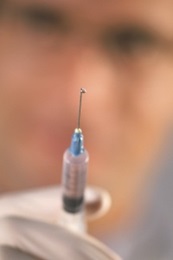Bone Grafting
What is bone grafting?
Bone grafting is a surgical procedure that uses transplanted bone to repair and rebuild diseased or damaged bones. A bone graft is a choice for repairing bones almost anywhere in your body. Your surgeon might take bone from your hips, legs, or ribs to perform the graft. Sometimes, surgeons also use bone tissue donated from cadavers to perform bone grafting.
Most of your skeleton consists of bone matrix. This is the hard material that helps give the bones their strength. Inside the matrix are living bone cells. These make and maintain this matrix. The cells in this matrix can help repair and heal bone when necessary.
When you break your bone, the healing process begins. As long as the break in your bone is not too large, your bone cells can repair it. Sometimes, though, a fracture results in a large loss of bone, like when a large chunk of the bone crumbles away. In these cases, your bone might not fully heal without a bone graft.
During a bone graft, your surgeon inserts a new piece of bone in the place where a bone needs to heal or join. The cells inside the new bone can then seal themselves to the old bone.
Surgeons often perform bone grafting as a part of some other medical procedure. For example, if you have a bad fracture of your thighbone, your healthcare provider might perform a bone graft as part of other necessary repairs on your bone. Your healthcare provider might make an incision in your hip to remove a small piece of your hip bone, using that to perform your graft.
In some cases, an artificial material is used in a similar way, but this is not a bone graft in the traditional sense. You will typically be put to sleep with general anesthesia for the procedure.
Why might I need bone grafting?
You might need bone grafting to promote bone healing and growth for a number of different medical reasons. Some specific conditions that might require a bone graft include:
- An initial fracture that your healthcare provider suspects won’t heal without a graft
- A fracture that you previously did not have treated with a graft and that didn’t heal well
- Diseases of the bone, like osteonecrosis or cancer
- Spinal fusion surgery (which you might need if you have an unstable spine)
- Dental implant surgery (which you might need if you want to replace missing teeth)
- Surgically implanted devices, like in total knee replacement, to help promote bone growth around the structure
These bone grafts can provide a framework for the growth of new, living bone. Hips, knees, and spine are common locations for bone grafting, but you might need bone grafting for a different bone in your body.
Talk with your healthcare provider about whether you want to use a bone from a donor or a bone from elsewhere in your body. If you use your own bone, you will have to have extra surgery to remove this bone. You won’t need this if you use donated bone, but donated bone has its own small risks. Talk with your healthcare provider about what makes sense for you.
What are the risks for bone grafting?
Bone grafting is generally safe, but it does have some rare risks.
- Infection
- Bleeding
- Blood clot
- Nerve damage
- Complications from anesthesia
- Infection from the donated bone (very rare)
There is also a risk that your bone might not heal well even with your bone graft. Many of your specific risks will vary according to the exact reason for your bone graft. These reasons include whether or not you are using donor tissue, your other medical conditions, and your age. For example, your bone graft might not be as likely to heal well if you smoke or if you have diabetes. Talk with your healthcare provider about all your concerns, including the risks that most apply to you.
How do I prepare for bone grafting?
Talk with your healthcare provider about how to prepare for your bone graft surgery. Ask whether you should stop taking any medicines ahead of time, like blood thinners. If you are a smoker, try to stop smoking before your procedure to help speed healing. Tell your healthcare provider about all the medicines you take, including any over-the-counter medicines like aspirin. Also, tell your healthcare provider about any changes in your overall health, like a recent fever.
Before your procedure, you may need additional imaging tests, like X-rays, CT scan, or magnetic resonance imaging (MRI).
You may need to make additional arrangements ahead of time, depending on the reason for your bone grafting. For example, if you won’t be able to put weight on your leg after your surgery, you may need to rearrange your living arrangements.
Do not eat or drink after midnight the night before your procedure.
What happens during bone grafting?
The details of your bone grafting surgery will vary a great deal according to the reason for your surgery. Ask your healthcare provider about the details of your particular surgery. An orthopedic surgeon will perform your procedure aided by a team of healthcare professionals. As an example, you might expect:
- You will receive anesthesia to make sure that you won’t feel any pain or discomfort during the procedure.
- Someone will carefully monitor your vital signs, like your heart rate and blood pressure, during the operation.
- After cleaning the affected area, your surgeon will make a cut through the skin and muscle surrounding the bone that will receive the bone graft.
- In some cases, your surgeon will also make a different cut to harvest your bone graft. This might be from your hip bone, leg bone, or ribs. Using special tools, your surgeon will remove a small portion of bone.
- Your surgeon will insert the bone graft between the 2 pieces of bone that need to grow together. In some cases, your healthcare provider might secure the bone graft with special screws.
- Your surgeon will make any other necessary repairs.
- The layers of skin and muscle around your treated bone will be closed surgically and, if necessary, around where your bone was harvested.
What happens after a bone grafting?
Talk with your healthcare provider about what you can expect after your surgery. You may have some pain after your procedure, but pain medicines may help to relieve the pain. You should be able to resume a normal diet fairly quickly. You may get some imaging, like an X-ray, to make sure your surgery was successful. Depending on the extent of your injury and your other medical conditions, you might be able to go home the same day.
Your healthcare provider will give you detailed instructions about how you can move the area that received the bone graft. This usually involves keeping the area immobile for a while. This might require a splint or a brace. You’ll also probably need to avoid putting weight on the area. You may need physical therapy to restore strength and flexibility to your muscles.
You might need to take medicines to prevent blood clots (a “blood thinner”) for a little while after your surgery. Your healthcare provider might not want you to take certain over-the-counter medicines for pain, because some of these can interfere with bone healing. Your healthcare provider may advise you to eat a diet high in calcium and vitamin D as your bone heals. If you smoke, your healthcare provider may also advise you to stop smoking, because this may interfere with bone healing.
You might have some fluid draining from your incision. This is normal. But, let your healthcare provider know right away if the draining is severe. Also, let your healthcare provider know if your wound has increased redness or swelling, or if you have severe pain, loss of feeling, or a high fever or chills.
Make sure to keep all of your follow-up appointments. You may need to have your stitches or staples removed a week or so after your surgery. Your healthcare provider may want to perform a series of X-rays to see how well your bone heals. Follow all your healthcare provider’s instructions carefully to have the best chance at full recovery.
Next steps
Before you agree to the test or the procedure make sure you know:
- The name of the test or procedure
- The reason you are having the test or procedure
- What results to expect and what they mean
- The risks and benefits of the test or procedure
- What the possible side effects or complications are
- When and where you are to have the test or procedure
- Who will do the test or procedure and what that person’s qualifications are
- What would happen if you did not have the test or procedure
- Any alternative tests or procedures to think about
- When and how will you get the results
- Who to call after the test or procedure if you have questions or problems
- How much will you have to pay for the test or procedure





